


 |
March 9, 2009: Las Vegas Trip Day 5 |
 |
March 7, 2009: Las Vegas Trip Day 3 |
 |
Return to the Index for Our Las Vegas Trip |
Today, we are prevailing on Ron Drew and Jay again for the use of their minivan to take a trip out to Hoover Dam. Ron has been there before, but Jay, Steve and Mario have not. Of course, Fred and I have, and this is something of a nostalgia trip for us. The last time we were here was in 1999, and at that time, there were seven of us here- Ron Mathis and Chris Young, Ron Drew and Lowery Evans, Fred and myself, and Mike Racke. What makes today's trip so much more poingnant is the fact that of those seven people, three of them- Mike, Chris and Lowery- are no longer with us. Lowery died in 2000, Mike passed away in 2001 and Chris died just six days ago (and, in fact, his memorial service will be the day after we return). I'll have a bit more to say about these events a little later on, when all of us gather and have our picture taken in the same spot as we had group pictures taken ten years ago.
Our Day Excursion to Hoover Dam
Getting to Hoover Dam
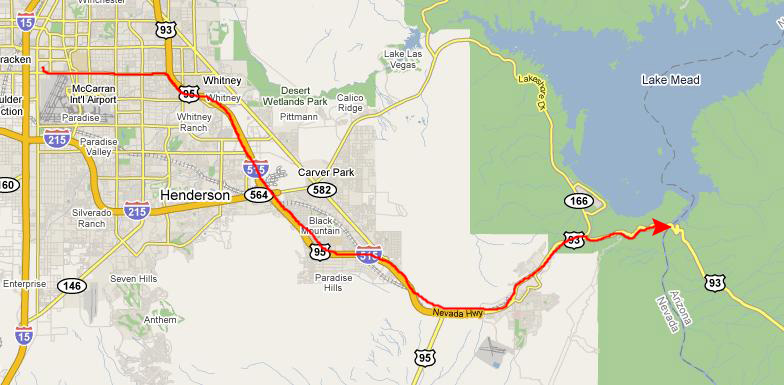 |
To get there, all we had to do was go east on Tropicana Blvd. (the street just south of the MGM Grand) until it intersected with I-515. Then we took that south and east. It eventually ends and turns into the Nevada Highway, and that two-lane road takes you right to (and across the top of) Hoover Dam. There is a lot of traffic on this road, much of it going past the dam into Arizona, and that is why a new bridge is being built south of the dam; the bottleneck at the dam where the road goes across the top of it has just become intolerable.
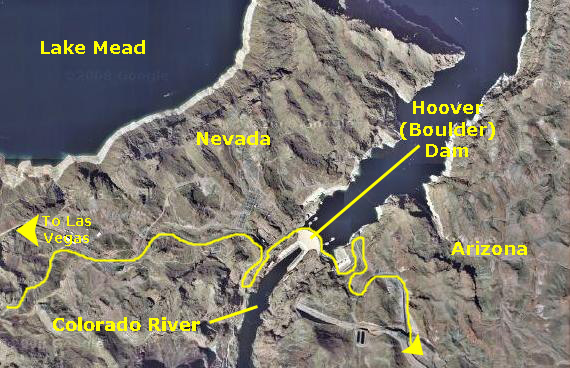 |
Before we take a look at the pictures taken here at the dam, I think I should orient you to the area immediately adjacent to the dam and show you the various landmarks that you will see in the pictures. So go on to the next section below.
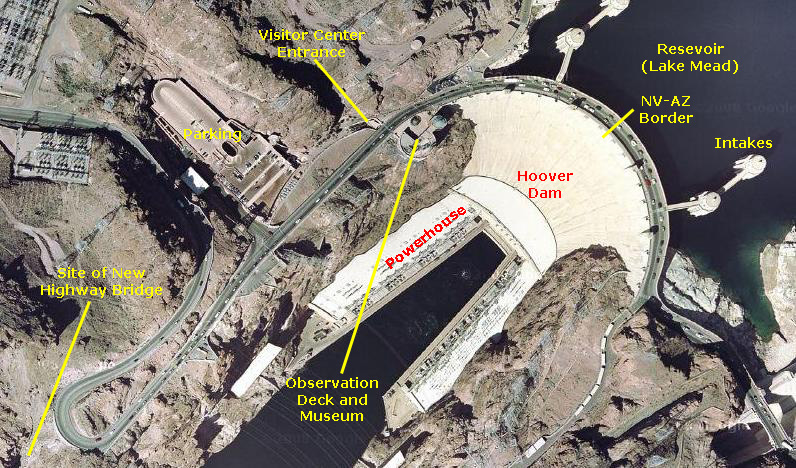 |
An Orientation to the Area Around Hoover Dam
From the parking structure, you follow the walkway to a set of escalators that take you down to the Visitor Center entrance. At that entrance, you can buy tickets for the tour (there is a long one and a short one, and we opted for the shorter of the two) or just an entry into the museum. Our tour took us way down into the interior of the dam and then through a long subterranean hallway to one of the powerhouses (more later). The tour ended with an elevator ride up, ending in the observation tower/museum.
We also walked out onto the patio of the observation deck to get a lot of good pictures, and then we walked on the sidewalks that take you all the way across the dam. We just went as far as the middle of the dam so we could get pictures looking downstream, pictures of the reservoir and the intakes, and the obligatory pictures of us straddling the state line.
So let's begin our visit with the first group of pictures.
(1) Outside at Hoover Dam (Nevada Side)

|
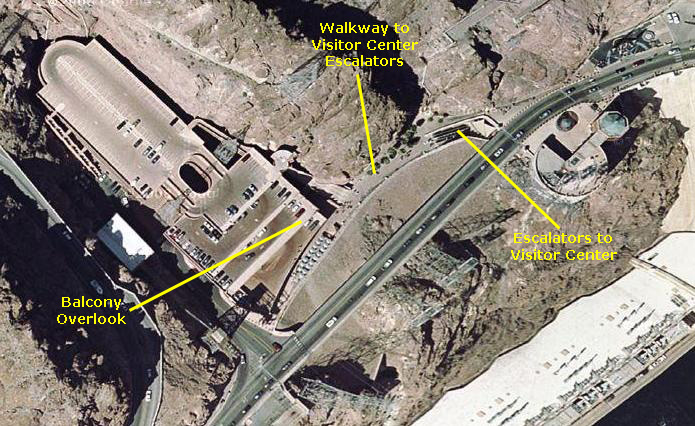 |
We walked past the actual entry, and Fred got a picture looking back towards the parking structure of Steve and I.
(2) Our Tour Inside Hoover Dam
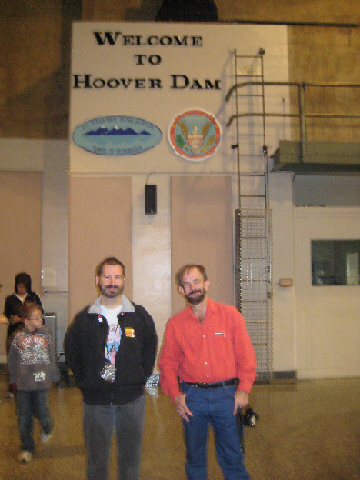 |
Then, we went back the way we had come and down another level in the elevator. This let us out at the entrance to another long tunnel to one of the two generator rooms. Here, we all gathered around a semi-circular balcony overlooking a long row of huge turbines, all spinning due to the force of the rushing water. Below are thumbnail images for two good pictures of this generator room; click on them to see the full-size images:
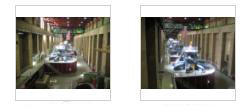
|
While our guide was explaining what it was we were looking at, I made a movie of part of his explanation as I panned around the huge room, and you can use the player below to watch it:
|
In this movie, you can listen to part of the explanation our tour guide gave us on how the generators work, their output and so on, and you can see the entire room as I pan the camera around. |
(3) Inside the Observation Tower
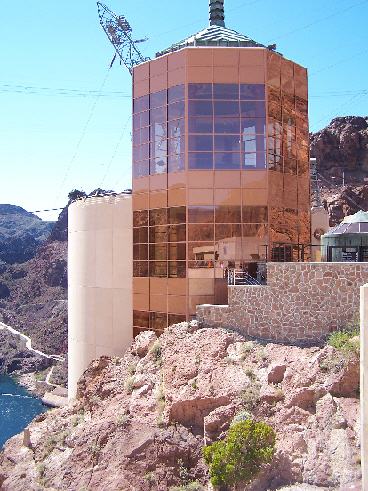 |
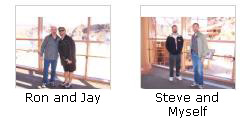
|
We also saw a couple of exhibits relating to the new highway bridge being built south of the dam. You can click on the two thumbnail images below to see some drawings and a model of what the bridge will look like when completed:
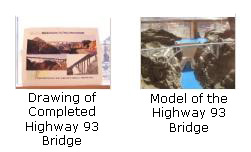
|
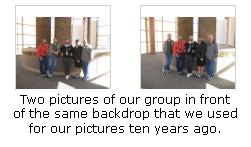
|
Lastly, I mentioned that the observation tower contained a number of interesting exhibits, and Fred took some pictures of almost all of them. Each describes some aspect of the dam or its construction, and if you want to learn more about Hoover Dam, you can click on the thumbnail images below and have a look at these exhibits:

|
(4) On the Observation Tower Outside Deck
 |
To begin, imagine that you are standing on the observation deck, and you first look directly east across the face of the dam. A couple of examples of the view that you would see are here and here. And if you turn and look in the other direction, you can see the Nevada Highway as it approaches the dam (with the beginnings of the new highway bridge in the background), and also the parking structure on the other side of the highway. You might note that the traffic is getting very heavy; we drove out here over two hours ago, when the traffic was fairly light. Now, it is backed up quite a ways from the dam- hence the construction of the new highway bridge that you can see in the first picture.
When we moved over to the eastern edge of the deck, we could look directly down at the base of the dam and, moving the camera just a bit southward, we could see the the powerhouses, one of which we were inside during our tour. (The water that turns the turbines comes out in the area between the two powerhouses). Then, as you continue to pan downstream with the camera, you get excellent views of the Black Canyon just below the dam and, finally, the Colorado River resuming its course southward towards the Grand Canyon. In this last picture, you can also see the Arizona side of the new highway bridge being built.
Out here on the observation deck, there were more exhibits and signs that offered a lot of interesting explanation of what we were looking at. Here are four of those informative signs that you might find interesting; just click on the thumbnail image to read it:

|
We spent a fair amount of time out here on the observation deck, just looking around and marveling at the views- of nature and of man's construction. Below are some thumbnail images for the pictures that we all took here. To look at any picture, just click on its thumbnail:

|
Fred and I took a couple of good movies out here on the deck and you can use the players below to watch them:
|
In this movie that Fred took, he will show you the activity on the observation deck and pan across Hoover Dam from side to side and top to bottom. |
In my movie, I begin by looking downstream at the Black Canyon, and then bring the view upstream, past the new highway bridge, and then to the base of Hoover Dam and upwards to the top. I've tried to add as much informative narration as I can, some of it taken from the various signs and exhibits. |
(5) Memorials and Monuments

|

|
(6) Walking Out on Hoover Dam
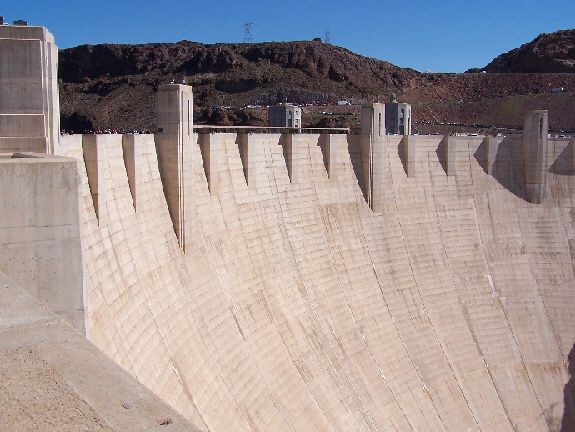 |
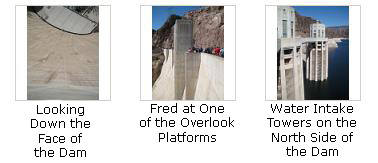
|
We got to the middle of the dam and then waited for a break in the traffic (which was, by now, almost a continuous stream of cars moving in both directions across the top of the dam), and then crossed to the north side of the dam. Here, in almost the exact middle of the dam, we found the plaque indicating the position of the Nevada‑Arizona border. We stopped to take a few pictures here (one of which you can see in the section below) before we headed back towards the western end of the dam, this time walking along the sidewalk on the north side of the road.
On our way out across the dam and on our way back, Steve, Fred and I took numerous pictures. I have had to severely cut them down in number for inclusion here- weeding out those that duplicated views you've seen earlier. If you would like to look at some of the pictures that remained after the culling process, just click on the thumbnail images below:
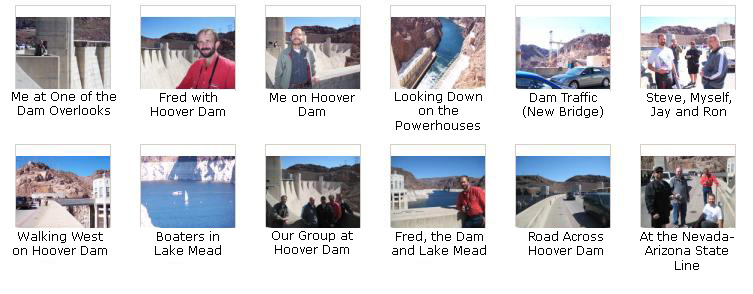
|
I also took a movie while walking across the dam:
|
In this movie, I begin by walking ahead of the rest of the guys and looking back on them, and then I pan around the top of the dam, looking at Lake Mead and downstream. All the while I am walking towards the Nevada-Arizona State Line, and eventually cross into Arizona. |
(7) The Bypass Tunnels
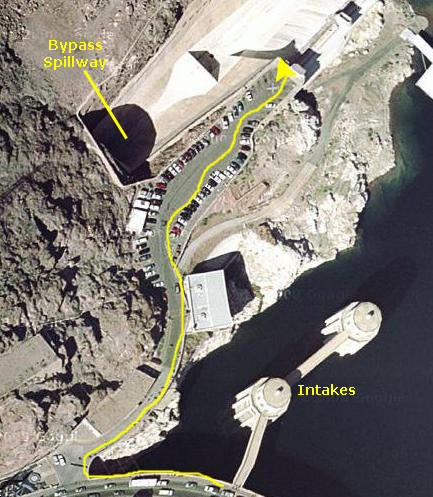 |
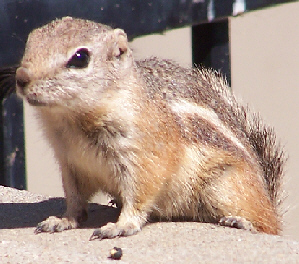
At the end of the road and parking area, I came to the spillway. This spillway was, originally, one of the bypass spillways that were constructed to divert the water of the Colorado River around the site of the new dam. From the end of the parking area, I was able to look directly down into the spillway tunnel. Once the dam was completed, then the entry to the spillway bypass was itself dammed up with the miniature dam shown here. Now this bypass tunnel serves as a safety valve, should the flow of the Colorado fill Lake Mead faster than the turbine tunnels could handle it.
From this point, I could also get a good view of the north side of the dam, and you can see the lake right up against the dam as well as some of the water intakes for the turbine tunnels. Finishing up here, I walked back down the road to rejoin the rest of the guys.
(8) The New Highway 93 Bridge at Hoover Dam
(The Mike O'Callaghan-Pat Tillman Memorial Bridge)
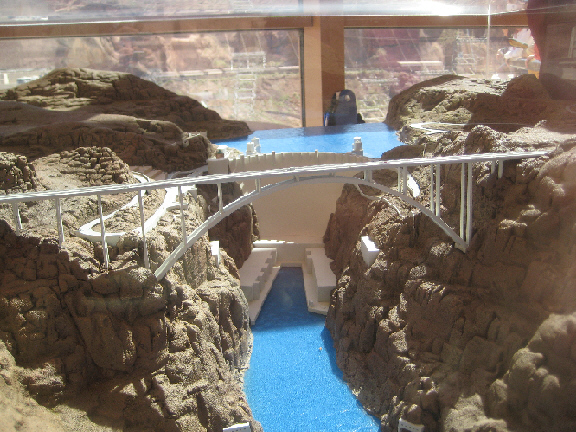 |
Because of the magnitude of this project, it will be constructed in four distinct phases: the Arizona Approach, the Nevada Approach, the Colorado River Bridge (officially designated the Mike O'Callaghan-Pat Tillman Memorial Bridge by an Act of Congress on September 15, 2004) and final roadway surfacing.
Construction of the Arizona approach began in January, 2003, followed by the Nevada approach in October 2003 and the bridge in early 2004. The entire Hoover Dam Bypass Project is expected to be completed in 2010 at a cost of about $240 million.
At the right, you can see a picture I took of the model of the bridge that is in the observation tower exhibit area. You may note when you look at some of the pictures in the gallery below that there have, apparently, been some design changes.
Among the project highlights are:
| -- | Construction of 3.5 miles of new 4-lane roadway including seven bridges in addition to the Mike O'Callaghan-Pat Tillman Memorial Bridge | |
| -- | Excavation/Embankment of over 3.5 million cubic yards of earthwork | |
| -- | 60,000 cubic yards concrete (243,000,000 pounds) | |
| -- | 8,000 tons steel (16,000,000 pounds) | |
| -- | Will be the longest concrete arch in the US and 5th longest in the world, having a 1,900-foot overall length with a 1,060-foot main span | |
| -- | Will be the highest concrete arch construction in the US, being built 880 feet over the Colorado River | |
| -- | Will use the highest concrete strength of any major arch highway bridge in the US at 10,000 psi | |
| -- | Over 1,200 trade and craft workers will participate in manufacture and construction of the Hoover Dam Bypass |
We took quite a few pictures of this new bridge under construction. All of them show some different aspect of the construction project, but you may not want to look at all of them. Just click on the thumbnail image for any picture that you would like to see:

|
(9) Views of Lake Mead
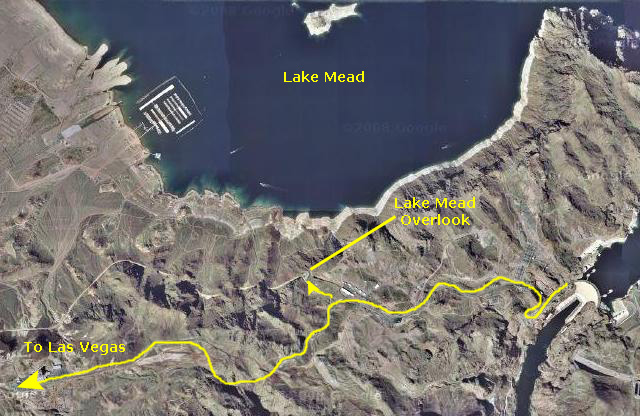 |
On the aerial view at left, I've marked where this turnoff and overlook were located. You may note in the pictures below that the water level in the lake is lower than it seems to be in the aerial view; this is certainly true. The floating marina, for example, is a good deal further east than it is in the aerial view, as the anchoring mechanism has allowed it to float further out so that it still floats on the lowered water surface.
The Boulder Dam Project created Lake Mead. Completed in 1935, the dam blocked the Colorado River as the river turned southward here into Black Canyon. The backed-up waters formed a 110-mile long series of basins and coves, now known collectively as Lake Mead.
Since its establishment in 1936, the recreation area around Lake Mead has been managed by the National Park Service. In 1947, Boulder Dam was renamed Hoover Dam. At that time, the area to Lake Mohave, stretching 67 miles southward from Hoover Dam to Davis Dam, was added to the recreation area.
In 1964, Congress established this entire area as the Lake Mead National Recreation Area. This was the first nationally designated recreation area in the country.
Below I have put thumbnail images for some of the pictures that we took here at the overlook, and you can click on those thumbnail images to view the full-size pictures. As you do, notice how the drought of the last two years has lowered the lake levels; the lake is down some 80 feet from its normal level.
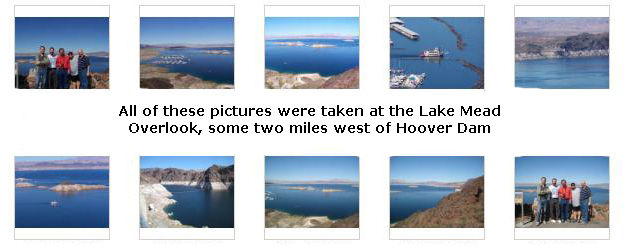
|
Here is the movie taken here at the overlook:
|
In this movie, taken at the overlook for Lake Mead, I'll pan around the entire vista, and it will be as if you were standing there looking at the view with us. |
This ended our visit to Hoover Dam and Lake Mead, and we headed back to Las Vegas to collect Mario (who had been feeling poorly this morning) and go have some lunch.
Lunch at New York, New York
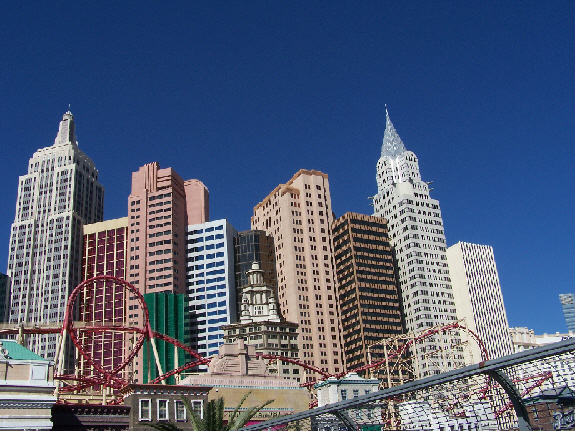 |
Below are some thumbnail images for pictures we took while waiting for our food to arrive; click on them to view the full-size images:
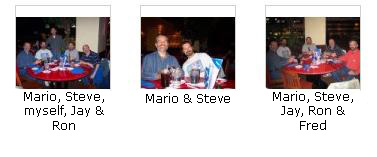
|
The most interesting thing about this restaurant was the ceiling decoration. Attached to the ceiling and tapering down to essentially "hang" at the back part of the restaurant, was a huge "sculpture" of a map of the United States. It appeared to be either one large sculpture or a collection of individual state sculptures that were attached loosely together. Each state was molded out of what appeared to be three or four-inch-thick styrofoam, painted and decorated with items that might be found at that general location. Texas had its oil wells and space center; Florida had its oranges; Kansas had its wheatfields. It was a very interesting decoration, and must have taken quite a bit of time to put together. Below are some thumbnail images of sections of this sculpture; click on them to see the detailed pictures:

|
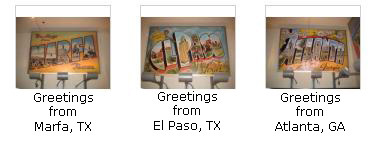
|
I made a movie in the restaurant, too:
|
Some of the photographs of the unique ceiling sculpture that we took in The American Cafe didn't turn out all that well, so I went ahead and made a movie of the sculpture as well. |
After lunch, we headed out to walk along the Strip once again, heading to the fountains at Bellagio. I want to show you four more hotels, each of which we visited this afternoon, but most of which we'd visited on other days, too.
Hotel #15: Paris Hotel and Casino
Aerial View and Location
 |
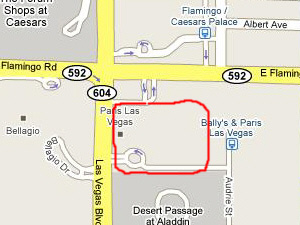
In the aerial view at left, I've pointed out the Eiffel Tower, the Arc d'Triomphe and the Mongolfier Balloon. You can also see the Fontaine des Mers just north of the balloon.
Description
|
History
Building began under Hilton Hotels, which purchased Bally Entertainment in 1996; Hilton's casinos were subsequently spun off into Park Place Entertainment, which purchased Caesars World in 2000 and changed its name to Caesars Entertainment in 2004. At the time of its opening, the hotel ran amusing television advertisements throughout the United States implying that it had ensured the authenticity of its reproductions of Paris landmarks, culture and cuisine by looting the real city. When the scale model of the Eiffel Tower was built, it was planned to be full scale, but the airport was too close and the tower had to be shrunk. The scale is approximately 5/8ths.
Paris cost $785 million to build, and occupies 24 acres. The casino itself contains a sky painted ceiling, a popular choice among Las Vegas resorts. A unique aspect of Paris Las Vegas is that the back legs of its Eiffel Tower actually come down through the ceiling into the middle of the casino floor. In November 2006, the Paris sports book was temporarily shut down pending an investigation of its employees for allegedly underreporting tips.
In 2007, Paris Las Vegas premiered their new show The Producers, headlined by David Hasselhoff. Once continuing issues regarding Hasselhoff not showing up to shows were fixed (i.e., he left the show), the show refocused on Max, played by Tony Danza, who came on as the celebrity actor for the show until its end in February 2008. To counter the 2008-2009 economic downturn, Harrah's focused on marketing its properties to specific segments of the population; as a result Paris is being marketed heavily towards gay and lesbian travelers.
Picture Gallery

|

|
|
This movie was taken outside the Paris Hotel and Casino, from the corner adjacent to the Fontaine des Mers. It shows the fountain and then pans up to show the height of the 5/8 scale Eiffel Tower. |
Hotel #16: Bally's Hotel and Casino
Aerial View and Location
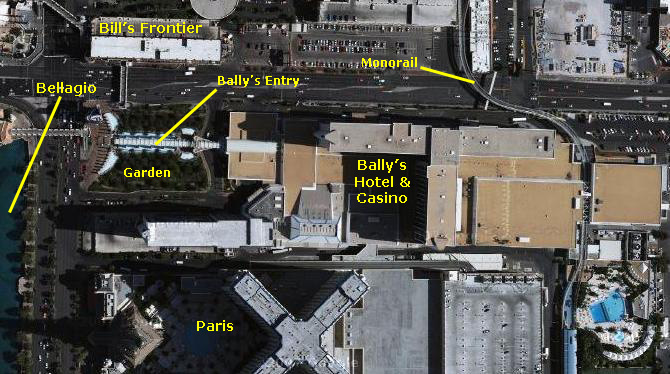 |
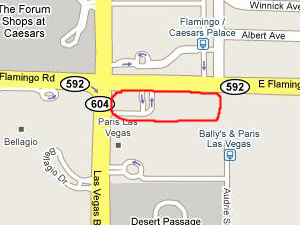
In the aerial view at left, I have marked a couple of the features that you'll see in the pictures we took, including the garden in front of the hotel and the unique "people mover in a tube" that leads from the Strip right to the base of the escalators that take you to the lobby entry and casino floor.
Description
|
History
On November 21, 1980, it suffered a fire in the casino that spread through the hotel, resulting in a death toll of 87 guests and employees. The fire was, and still remains, the largest disaster in Nevada history in terms of loss of life and a major reform of city fire safety, which are now among the strictest in the United States. The facility was rebuilt in eight months.
The hotel was sold in 1985 to Bally Entertainment Corporation and the property's name was changed to Bally's (the MGM Grand name was transferred to the former Marina Hotel, now known as MGM Grand Las Vegas). Bally Entertainment Corporation was purchased in 1995 by Hilton Hotels Corporation whose casino resorts division was subsequently spun off and became Caesars Entertainment in 2003. Harrah's Entertainment, Inc. acquired the property with its purchase of Caesars Entertainment, Inc. in June 2005.
Picture Gallery

|
Hotel #17: The Monte Carlo Hotel and Casino
Aerial View and Location
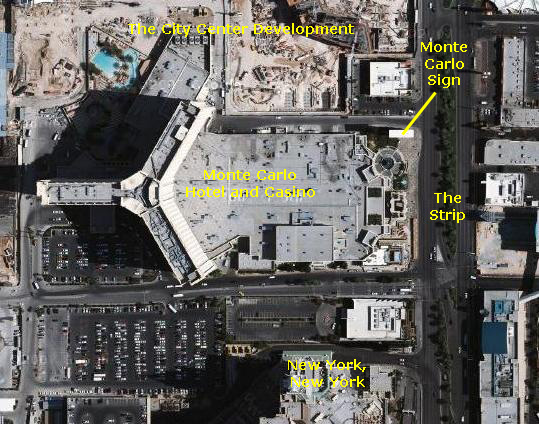 |
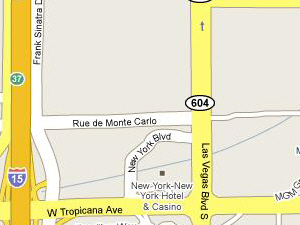
I've marked some of these landmarks in the aerial view at left, and I have also pointed out the huge Monte Carlo display sign that you will see in many of the pictures we took while walking along the Strip.
Description
|
History
The Monte Carlo opened to the public on June 21, 1996 at 12:01 AM. There was an invitation-only VIP pre-opening celebration the prior day starting at 7:00 PM. The party included a 12 minute fireworks show at 11 PM.
On January 25, 2008 at 10:57 AM, a three-alarm fire was reported on the exterior of the top floors and roof of the casino. Portions of the hotel facade's exterior insulation finishing system burned and with some debris falling off and starting smaller secondary fires on ledges three floors below. The fire was fully contained an hour after it began. It was an exterior fire, although there was water damage to parts of several floors. Monte Carlo guests were accommodated at nearby MGM Mirage sister properties. The Clark County Fire Chief stated 13 people suffered smoke inhalation. The ambulance company reported that 17 people with minor injuries were taken to area hospitals. Fire Chief Steve Smith credited the 120 firefighters for quickly containing the fire, as the sprinkler system could not reach outside.
A subsequent investigation found that welders working to set up window-washing equipment on the roof started the fire. The Hotel & Casino reopened to guests on February 15, 2008. MGM-Mirage officials put the total losses due to fire damage and loss of business at just under $100 million.
Picture Gallery

|
Hotel #18: Caesar's Palace Hotel and Casino
Aerial View and Location
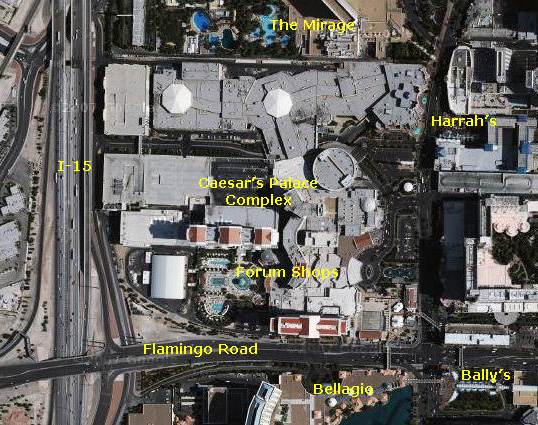 |
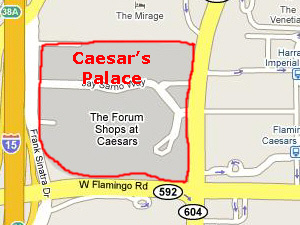
I've marked these hotels in the aerial view at left.
Description
|
History
Sarno contracted many companies to build the hotel, from the Roman landscapes it presents, to the water fountains that have been stages of various events and the hotel's swimming pools. On August 5, 1966, the hotel was inaugurated, with Andy Williams and Phil Richards providing entertainment; they both played Julius Caesar at a play that night. Two days later, Latin bandleader Xavier Cugat and flamenco guitarist Charo became the first couple to marry in the new establishment.
In 1969, Stuart and Clifford S. Perlman, founders of the Lums chain of restaurants, purchased the hotel. On July 15 of that year, executives broke ground on an expansion area of the hotel, and they buried a time capsule in the area, but the time capsule was stolen days later. In 1973, the Del Webb company was contracted to build a 16-story building adjacent to the Palace. The project was finished in 1974. Many top performers, such as Celine Dion, Bette Midler, Liberace, Elton John, George Burns, Diana Ross, Cher, Julio Iglesias, Judy Garland, David Copperfield, Gloria Estefan, and Frank Sinatra have performed at the hotel.
During the 1980s, the hotel opened an Atari game room that had over 60 Atari video game arcade machines. In addition, the hotel boasted its own Grand Prix auto race circuit, and a large number of boxing headline matches in its huge sports arena. Even Robbie Knievel in 1989 successfully completed a motocycle jump of the main fountain- something that his father could not do years before.
The hotel's management wanted it to have a new, family-oriented atmosphere as the 1990s approached, a trend mirrored by many of the big Las Vegas resorts. This move was not strange to Las Vegas hotel owners, as most hotels there were planning to modernize anyway by adding more children features and making Las Vegas hotels seem more family friendly and less gambler oriented. In 1992, The Forum Shops at Caesars opened; it was one of the very first venues in the city where shopping, particularly at high-end stores, was an attraction in itself. Store-fronts were made to look like exteriors, in corridors with sky-painted ceilings. At points where the corridors change directions, elaborate marble fountains were placed, one with a sound-and-light show which played periodically. The fourth phase, which opened on October 22, 2004, has the second-built circular escalator in the United States. The other is at the Westfield San Francisco Centre.
Caesars has opened the Roman Plaza, an open-air area with a cafe on the corner, and the Colosseum theater, where Céline Dion (A New Day...) and Elton John (The Red Piano) were regular performers. The Colosseum was specifically built for Dion's show, a spectacular produced by former Cirque du Soleil director Franco Dragone. Dion's show was also notable for having some of the highest ticket prices for any show in the city, with seats as high as $220 each; nonetheless, the show regularly sold out.
Caesars Palace opened the Augustus Tower in August 2005. It stands 46 floors high and is perpendicular to the Strip. In 2005, Harrah's Entertainment acquired Caesars Entertainment and became the owner of Caesars Palace. In May 2007, Bette Midler was announced as Dion's formal replacement. Midler will reportedly only perform about 100 shows a year, with Elton John continuing to perform his popular Red Piano show 50 nights a year while Midler is on hiatus. After taking a three-year hiatus, Cher, following her Farewell Tour, is also returning to the stage with a three-year contract to perform 200 shows beginning May 6, 2008. Harrah's Entertainment announced in January 2009 that completion of the new Octavius Tower has been stalled due to lower demand. Only the exterior of the tower will be completed.
Picture Gallery
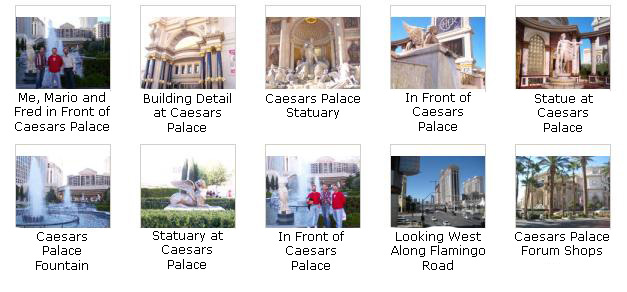
|
The "American Superstars Show" at the Stratosphere Hotel and Casino
Hotel #19: The Stratosphere Hotel and Casino
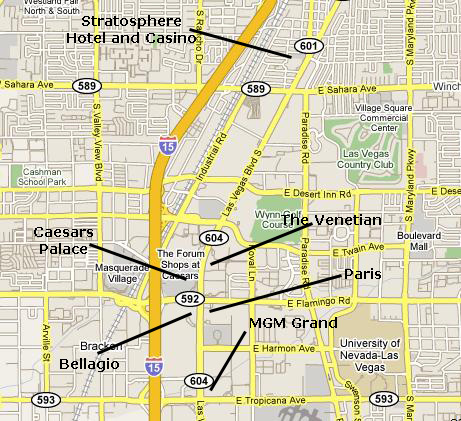 |
The Stratosphere is the northernmost of the major Strip casinos and the only one actually in the City of Las Vegas, as the rest of the strip south of Sahara Avenue is in the unincorporated townships of Paradise and Winchester. Because it is inside the city limits, the Nevada Gaming Commission groups it with the other Downtown Las Vegas casinos.
Following its completion in 1996 it was initially less popular than first envisioned due to its location on the extreme north end of the strip, far away from the most popular hotel casinos, but its low room prices and unique offerings eventually ensured its success. While many tourists consider its location to be inconvenient, others feel the location is an advantage since it is equidistant between the more popular strip casinos and the downtown area (which includes the Fremont Street Experience).
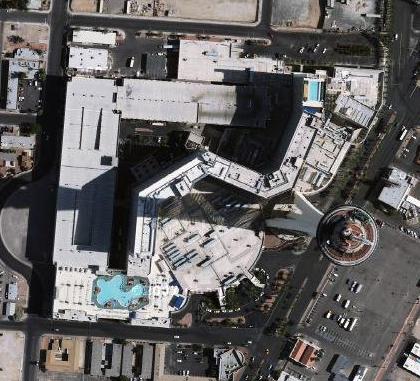 |
The Stratosphere Las Vegas includes the tower, hotel, and casino and it is owned by Whitehall Street Real Estate Funds, an affiliate of Goldman, Sachs & Co who purchased American Casino & Entertainment Properties which includes the Stratosphere along with three other properties. The sale closed on 21 February 2008 for $1.3 billion. The property's signature attraction is the 1,149 ft Stratosphere Tower, the tallest free-standing observation tower in the United States and the second tallest in the Western Hemisphere, surpassed only by the CN Tower in Toronto, Ontario. It is the tallest free-standing structure in Nevada, and it is the second-tallest free-standing structure west of the Mississippi River, after the Kennecott Smokestack in Magna, Utah. You can see a really interesting diagram of the top of the tower if you will click here. The hotel is a separate building with 24 stories, 2,444 rooms and an 80,000 square foot casino.
In the early 1990s, The Stratosphere was conceived by Bob Stupak to replace his Vegas World casino. At the conception of the project, one of the planned rides was to be a giant ape that would carry riders up and down one of the tower's columns. Original plans called for the Stratosphere to tower beyond 1,800 feet tall, making it the world's tallest building at that time. However, due to possible interference with nearby McCarran International Airport and any possible flights that come through Las Vegas, the tower's proposed height shrank multiple times until it stopped at its present height.
|
The Stratosphere opened on April 30, 1996. Shortly after opening, the Stratosphere Corporation was forced to file for bankruptcy. This caused construction on the second tower to stop with only a few stories partially built and allowed Carl Icahn to gain control through one of his companies by buying a majority of the outstanding bonds. A major addition was completed in June 2001 for $1 billion that included finishing the 1000-room second hotel tower.
In the early 2000s, the company attempted to get approval for a roller coaster that would run from several hundred feet up the tower and, in the last proposal, across Las Vegas Boulevard. Part of that last proposal included an entry monument on the ride over Las Vegas Boulevard welcoming people to the City of Las Vegas. The City Council did not approve the project due to objections from the neighbors over possible noise from the enclosed cars on the proposed ride. This ride was intended as a replacement for the never-built ape ride.
Since its opening in 1996, five people have jumped to their deaths from the top of the tower.
Our evening visit to Stratosphere was the only time we had an opportunity to take pictures in and around the hotel, so there aren't many of them. But if you will click on the thumbnail images below, you can see the pictures that we did take:

|
The "American Superstars" Show
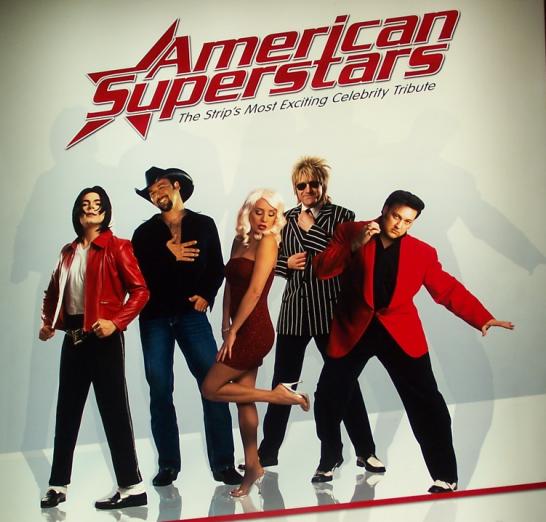 |
Mario's tickets got us to a great table right down front, which was good for Mario in doing his review. The tickets even included a drink for each of us, so all of us got a frozen drink at the bar outside the theatre. I couldn't take pictures or movies during the show, but afterwards, the "stars" appear outside the theatre for photo sessions with anyone who wants to have their picture taken. I got four good photos of this process, and if you will click on the thumbnail images below, you can see them:

|
In the Stratosphere Lounge

|
|
The first movie that I took here in the Stratosphere Lounge is of the lounge itself and the bar area where we were seated. You can hear some of the entertainment in the background. |
The second movie that I took here in the Stratosphere Lounge gets close to the windows of the circular, revolving restaurant, and show views looking south and west down the Las Vegas Strip. |
We had a great time at American Superstars, and after our drinks in the Lounge, we headed home to the MGM Grand on this, our last evening in Las Vegas.
You can use the links below to continue to another album page.
 |
March 9, 2009: Las Vegas Trip Day 5 |
 |
March 7, 2009: Las Vegas Trip Day 3 |
 |
Return to the Index for Our Las Vegas Trip |